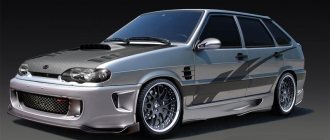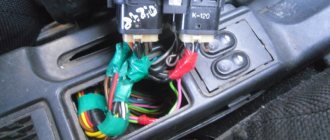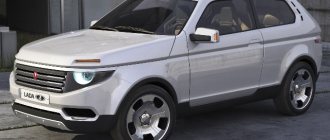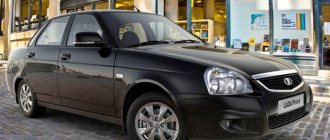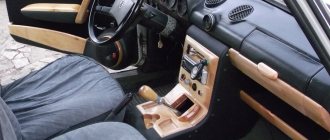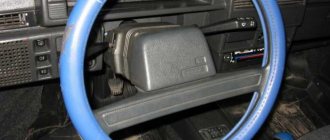In this article, we decided to collect a photo and video selection of tuning the interior of the VAZ 2110. Ten is a very common VAZ model. And you can see the VAZ 2110 almost anywhere. And, as you know, every car enthusiast wants his car to be special and unusual. And that’s why tuning enthusiasts modernize and tune the car’s interior. Tuning the interior of a VAZ 2110 is not a simple thing. When properly tuning the interior, dozens of parts need to be replaced, since the factory ones are real rubbish and are not suitable for creating an ideal interior tuning.
In the interior of the VAZ 2110, the seat trim can be tuned. They are covered with leather, chiffon, velvet and other materials. The dashboard and glove compartment, where you can place a small monitor or radio, are also subject to tuning. Tuning the interior of the VAZ 2110 can be seen clearly in the video and photo.
This photo, tuning the interior of a VAZ 2110, shows excellent tuning. The author used his imagination to the maximum and produced a real exclusive. I covered the front pillars and some elements of the dashboard and doors with red velvet. What gave the car an unusual charm. The steering wheel was also replaced with a similar one from Mitsubishi. Tuning the interior will not provide fast upgrades, but it will add aesthetic beauty to the car.
And it will give a lot of positive emotions to the driver and passengers.
Don't forget to look at the article: photo tuning of the VAZ 2107 interior.
The interior tuning of this dozen was made to order from a real neat guy. Since the seats, dashboard and doors of the car are covered in beige leather with black inserts. There are no unnecessary parts in this interior tuning, which gives a neat appearance. And as you may have noticed, it is better not to touch the steering wheel with dirty and greasy hands.
You can also find a similar article on our website: photo tuning of the VAZ 2110.
Video tuning
This small but very capacious video, tuning the interior of a VAZ 2110, contains the best tunings from all over the Internet. If you liked the article, photos and videos, leave your comment for our users or subscribe to our channel. Where you can see the latest news from our website.
VAZ-2110 - characteristics, review, photos, configurations
VAZ 2110 is a Russian front-wheel drive sedan. In common language - “ten”, which is what the model means. Serial production of the Lada 2110 began in 1996. Initially, the passenger car was produced only as a sedan. Later, the auto giant expanded its lineup with hatchbacks and station wagons.
The 110 model was first demonstrated to then Russian President Boris Yeltsin during a visit to the Volzhsky Automobile Plant in 1992. But the economic crisis prevented the car from quickly being put into mass production.
The appearance of the new model led to many innovations noticed by domestic drivers. For them, the “ten” became almost a foreign car. Production of the “ten” ended in 2007, and it was replaced by a new model – Lada Priora. The entire Lada model range.
CAR HISTORY
In addition to the fact that the body of the Lada of the tenth family had smooth lines and was not at all similar to the body of the already boring “99th” model, the 110th model was able to introduce an abundance of new elements that had not previously been seen on vehicles produced by the Volzhsky Automobile Plant. Among the innovations are the presence of an adjustable steering wheel, glued windows, gas hood supports and air conditioning.
After they began installing a sixteen-valve power unit on the Lada 110, it became clear to everyone that “it’s better not to joke with Tazami,” since the car could even leave some foreign cars behind. The “Ten” was produced with three versions of equipment: standard, norm and luxury. Despite the stoppage of production of the Lada 2110 in the Russian Federation, the model is still produced in Ukraine today as the Bogdan 2110.
Work on the design of the 10th model began back in 1983. The very first car of this class was supposed to be a sedan with a rear-wheel drive layout. But the developments were never able to reach their own finish line. A little later, the company decided to start developing a vehicle on the VAZ-2108 platform.
However, the cost of this machine was exorbitant, so the developers decided to freeze this project as well. Over time, all the developments resulted in the VAZ-21099 car. At the first time of production, the car came with a carburetor power system, and after 2000 they decided to install distributor fuel injection (injector).
EXTERIOR
At the time of its release, the VAZ 2110 had a modern look, but at the same time, it became the subject of criticism and discussion among automotive experts. Many people think, looking at some elements, that the design of the car is unattractive. The most problematic area of the design is the rear wing.
The rear of the VAZ, when viewed in profile, seems too heavy. Although, if we compare it with the VAZ 21099, the new model has noticeably improved aerodynamic performance. And as a result of fairly good streamlining, the new VAZ 2110 has become more economical. There are no rectangular shapes here, like on the Samara, and overall the car looks neat.
Now bumpers began to be painted in body color, even in the cheapest modifications. This gave it a characteristic look, especially in those days when it was not always possible to find something like this even in foreign cars. And the most expensive modification - luxury, had additional headlights on the front bumper, and an additional stop light behind the rear window.
All body parts subject to corrosion are galvanized. The body part of the 10th Lada is made more than half of galvanized steel, which in itself increases anti-corrosion resistance.
However, even when purchasing a galvanized VAZ model, you won’t have to rest on your laurels, because those who did not do the anti-corrosion treatment could notice rust on the bottom of the car. Therefore, there is only one conclusion - anticorrosive should be done, regardless of galvanized steel.
Starting with the “norm” configuration, metallic paint is provided, and already in the “Lux” version the VAZ-2110 comes with fourteen-inch alloy wheels. Thanks to the glued glass, body rigidity increases, which is undoubtedly a plus, however, the gaps between body panels in some places can reach 7 millimeters.
If we talk about the door handles, they are made for a lower grip, and this in turn indicates that the vehicle was developed a long time ago. The lock cylinder, which is mounted separately from the handle itself, indicates that the Volzhsky Automobile Plant sedan is budget-friendly.
The appearance of the new model was clearly different from the already familiar “chisel shape” of the cars produced by the Volzhsky Automobile Plant. By reducing the drag coefficient, it was possible to reduce fuel consumption.
The dimensions of the car became larger in length, height and width, and the track along with the base was increased. There was also an increase in mass. Speaking of the latter, it is worth noting that the increase in weight allowed the “ten” to look more respectable, which raised it half a step higher in the table of ranks.
Because of this, changes had to be made to the “running”, although the most important decisions were left the same. Looking at its appearance, you notice that the “brainchild” of domestic automobile production has become heavier and duller. Although, if you evaluate each element, then everything is at its own level.
There are licked surfaces, powerful bumpers painted in body color, and a cute, albeit overly plump, “butt.” However, if you put all this together, then for unknown reasons it does not add up. The characteristic “chisel” grin that was on previous VAZ models is, fortunately, not to be found here.
The front glass of the car is glued in, which indicates the absence of a standard seal. The windshield wiper arm now has an aerodynamic clamp. If we talk about the luggage compartment (which includes the VAZ 2111), the opening has become wider and the loading height has become lower.
Linear dimensions of the VAZ and exterior
The dimensions of all VAZ cars of this model are almost the same:
- length - 4.285 m;
- width - 1.68 m;
- height - 1.48 m;
- rear track - 1.37 m;
- front track - 1.4 m;
- wheelbase - 2.492 m;
- weight - 1050 kg;
- driving pair of wheels - front;
- number of doors - 4;
- seats - 5;
- body type - station wagon.
Newer modifications 21112, 21113, 21114 have ground clearance of 165 mm, while the first versions of the station wagon have ground clearance of 160 mm. There are three types of tires: 175/70R13, 175/65R14 and 185/60R14. The tire size is affected by the configuration. The first number indicates the width of the tire, the second is the percentage of the tire profile to the width. The designation R indicates that the tire type is radial. The last number is equal to the mounting diameter of the disk in inches.
The appearance of the 111th Lada is nice. The body is created on the platform of the 2110 sedan, the appearance of which was the result of a complete restyling of models of previous years. The line of cars 2110, 2111 can be safely called the first modern cars made by AvtoVAZ.
Streamlining has been improved, new narrow headlights have been introduced. The car has a “lanky” shape in profile. The radiator grille and air intake are separated by a license plate; there are no bulges along the entire perimeter of the body. The side “skirts” are trimmed with black plastic, and in some modifications the bumpers are also trimmed.
The design of this model is classic, and when painted in any color, the VAZ looks solid.
INTERIOR
When starting to create the interior, the designers took into account some of the shortcomings of previous models and corrected them. Now the driver sits behind the wheel with his legs extended, and not as before, with his legs bent. The steering wheel itself has also changed its appearance, it has become much more beautiful. It has two points of support for the hands with a pillow, and it no longer blocks the visibility of the instruments. The designers have used soft plastic in the dashboard, which looks beautiful and feels good to the touch.
Thanks to this, the likelihood of any noise and squeaks is reduced. In new models, all large mechanical buttons are located on the sides of the dashboard. Climate control is intuitive.
The steering column has the ability to adjust the angle of vertical tilt and has a hydraulic booster. But, despite the updated steering wheel, its rim itself seems too thin to most. The rear seats are quite comfortable, but for three passengers it will already be a bit cramped. The luggage compartment has a volume of 480 liters.
The “Norma” package has front electric windows (it doesn’t matter whether there is a servo drive or not, they do not fully lower into the door), velor upholstery for seats and doors, as well as headrests on the rear sofa. The most expensive “Lux” configuration already has an on-board computer, heated rear-view mirrors and heated seats installed in the front.
The keys installed on the sides of the instrument panel make it impossible to forget that the car began to be designed back in the 1980s. Fuses and relays for the most important options of the car are located inside the car, on the left side under the steering wheel, which is very convenient.
In the famous “Samara” everything was not so convenient. We thought about loading narrow, long things - for this, the middle back of the rear sofa can be fully reclined, and the backs of the rear seats can also be reclined, but at a smaller angle.
Despite the still fairly limited space inside the car, updates to the front fascia and other elements have had a positive impact on the ergonomics of the cabin, which in turn has encouraged many consumers to buy the 2110.
The outside door handle is much better. The tongue from the famous “eight” disappeared, and now the door began to open by simply moving the lever up. Speaking about the doorway, it is worth saying that it has become quite convenient based on the width, but it is too small in height. Not to say that this will interfere, but the lack of headroom is noticeable.
However, the door itself no longer raises any complaints, partly thanks to the sharp upper corner. People of average height have no reason to be afraid, but those who are a little taller should be careful, as they can easily run into him.
In addition, the designers limited the opening angle of the door, which has only one intermediate fixed position. I was pleased that the threshold, which in 2108 was always covered with a layer of dirt in bad weather, now, thanks to the design features, always remains clean.
This point is very important, since when getting into a car you can easily get your clothes dirty if their edges touch the threshold. The driver is presented with a different dashboard, which no longer has the “oak” molded plastic – now the panel is made of soft elements reminiscent of the materials used in the VAZ “classic”.
Almost everywhere has become a little more comfortable thanks to the new upholstery of the chairs and the fleecy ceiling. Only the door trim remained molded, however, and it, in turn, became of higher quality.
Some nice touches include height-adjustable seat belts and door locking with central locking. The driver's seat has become more comfortable. The pillow and backrest were increased in width and began to distribute the load better.
You can no longer find that cushion in the lumbar region that bothers drivers, which was on the “eights”. Of course, there was no lateral support before and there is none now. The chair is still adjustable in only two positions, and the adjustments are still mechanical.
The gearshift lever of the VAZ 2110 was lengthened, which may be explained by the desire to reduce the effort when changing gears. The most important sensors - the speedometer and tachometer - now occupied the required space in the central part of the dashboard, and the direction indicators began to be placed on the sides. The center console has acquired indicators for the on-board control system.
Improved dashboard lighting
The VAZ 2112 dashboards have always had one problem: dim lighting. This was especially noticeable at night. So the first thing tuning enthusiasts do is change the light bulbs in the instrument panel. Initially, there are simple and extremely weak incandescent lamps. They are being replaced by white LEDs, which have two advantages: some are durable and economical. Here's what you'll need to get started:
- 8 white LEDs;
- medium sized flathead screwdriver.
Sequence of operations
To remove incandescent lamps from the VAZ 2112 instrument unit, you will have to unscrew it and pull it out.
- The steering wheel moves down all the way.
- Above the dashboard there is a visor into which a pair of screws are screwed. They are removed using a screwdriver.
Video: removing the instrument panel on a VAZ 2112
SPECIFICATIONS
POWER UNIT
The first VAZ-2110 was equipped with a carburetor, but especially for this model, with “automatic choke” without using the choke lever, which is present in conventional types of carburetor.
The VAZ 2110 engine had a volume of 1.5 liters and a power of 69 hp. pp., which contributed to economical fuel consumption - approximately 7.5 liters per 100 km. A little later, a 1.5-liter injection 16-valve engine debuted, developing 94 horses. It had a DOHC type gas distribution mechanism.
This engine reached the speed mark of 100 km/h in 12.5 seconds, and the maximum speed had already reached 185 kilometers per hour. The technical equipment of the Lada-2110, which had a sixteen-valve engine, looked quite decent compared to inexpensive foreign cars of those years. The last engine update took place in 2004 - then the volume was increased by 100 cubic cm.
The dynamic component of the 69-horsepower power unit is unlikely to impress even the driver of the 2106, however, reduced fuel consumption by 12 percent compared to the 99th often lured buyers. The maximum speed with such an engine is about 162 kilometers per hour.
Also, after a while, an injection 8-valve power unit 21102 was produced, the power of which was already 78 horses. The first hundred was reached in 14 seconds, and the maximum speed was 170 kilometers per hour.
Despite the more modest power in terms of technical components, when compared with 1.5-liter engines, the new engines boasted more increased torque. More importantly, the 1.6 16v valves did not bend when the timing belt broke, as often happened with 1.5 16v power units.
In the injection version of the engine, injectors very often fail, but you can repair them yourself or have them repaired by specialists. This video explains well how to clean and rinse the injectors yourself.
But very often when you do it yourself, you can make a lot of mistakes and break even a very working nozzle. Therefore, we advise you to contact specialists who can repair the injectors very quickly and efficiently and even with a guarantee. Why do we recommend it specifically - because they can even undertake such repairs that everyone refuses, they work throughout Russia and the CIS countries, they have direct supplies of spare parts from manufacturers, and there is express delivery.
In addition to the indicated engines, in the Russian Federation you can find the “Ten” with a two-liter Opell X20XEV power unit, which a little earlier was installed on the Opel Vectra A in one of the most powerful versions. Having such a powerful engine on board, the VAZ-2110 reached the first hundred in just 9.5 seconds, and the maximum speed limit rested at 205 km/h.
TRANSMISSION
The VAZ 2110 gearbox is represented by a five-speed manual gearbox with synchronizers in all main gears. The main gear is cylindrical, helical. The differential is conical, two-satellite. The clutch is single-disc, dry, diaphragm.
The car is easy to repair, and parts for it are not as difficult to find as for other cars. It’s not for nothing that many people recommend the Lada-2110 as their first car.
SUSPENSION
The front suspension is independent, with telescopic hydraulic shock absorbers, coil springs, lower wishbones with braces and a stabilizer bar.
The rear suspension consists of levers aggressively attached to the transverse support, coil springs that act as a spring element, as well as double-acting telescopic shock absorbers.
STEERING
Installation of a hydraulic power steering wheel is provided. The steering mechanism is rack and pinion.
BRAKE SYSTEM
All Lada-2110 models are equipped with disc brakes in front, which on the latest version are also ventilated.
Drum brakes were installed on the rear wheels. Engine modifications Lada 110
| Modification | engine's type | Engine capacity | Revolutions | Transmission | Acceleration up to 100 km/h, sec. | Maximum speed km/h |
| Lada 2110 1.5 | Petrol | 1499 | 5600 | Mechanical 5st. | 14 | 165 |
| Lada 21101 1.6i | Petrol | 1596 | 5200 | Mechanical 5st. | 13.5 | 170 |
| Lada 21102 1.5i | Petrol | 1499 | 5400 | Mechanical 5st. | 14 | 170 |
| Lada 21103 1.5i | Petrol | 1499 | 5600 | Mechanical 5st. | 12.5 | 185 |
| Lada 21104 1.6i | Petrol | 1596 | 5000 | Mechanical 5st. | 12 | 180 |
| Lada 21106 2.0i | Petrol | 1998 | 6000 | Mechanical 5st. | 10.5 | 205 |
| Lada 21108 1.5i | Petrol | 1499 | 5600 | Mechanical 5st. | 13 | 170 |
List of modifications of Lada 2111
This model was produced from 1998 to 2014. During this time, the following modifications of the VAZ 2111 came off the assembly line.
| Modifications | Characteristics | Years of manufacture |
| 21111 | With a 71-horsepower 8-valve 1.5-liter engine. | Produced from 1998 to 2004. |
| VAZ 21110 | More powerful engine with 77 hp. With. and a volume of 1.5 liters has 8 valves. | Produced from 2000 to 2009. |
| 21112 | A 1.6-liter power unit with even more power - 82 hp. With. and 8 valves. | 2004–2009. |
| 21113 | The number of valves has been increased to 16, volume 1.5 l, power 93 l. With. | Released in 2002. |
| 21114 | 16-valve 89-horsepower 1.6-liter engine. | 2004–2009. |
From 1999 to 2009, AvtoVAZ produced an alternative all-wheel drive version 2111-90, also known as Tarzan 2. A trial model Lada 21116 was also produced, equipped with a 2-liter Opel C20XE engine with a power of 150 horsepower. In 2009, AvtoVAZ stopped producing the Lada 2111, then from 2009 to 2014 the car was produced by Ukrainian forces. The name was also changed - Bogdan-2111.
The very first version of the car was equipped with a carburetor engine.
SAFETY
The Russian VAZ-2110 car was also crash tested. The result of the checks carried out in Togliatti turned out to be quite good, when compared with Volga, which, out of the available 16 points, was able to get only a meager 2.
After the frontal impact, the front driver's door was in place, and there was not even a single crease on it, and the windshield pillar was only slightly bent. However, the front door did not open due to the fact that she had propped the back door open. This is not a hopeless option, because it is possible to leave the car using the right door.
But what happens to the mannequins? The sensors that were installed on them did not show any life-threatening overloads! Despite the fact that the driver roughly hit the steering wheel and the dashboard, and the passenger sitting next to him hit the front panel, the head injury rate does not exceed the safe limit - 650 units.
This makes it possible to conclude that the probability of getting a head injury in people who are wearing a seat belt is less than 5%. The important advantages of the sedan were confirmed - the strong power structure of the interior. The conclusion is the following - before soft-boiled, but the interior is intact. This was achieved thanks to safety bars that were welded into the front doors. The material of the beams is not light planks, but steel pipes.
The seat slides were also able to withstand the collision, again not on their own, but thanks to the modernized profiles of the retainer teeth. A small load when the dummy's head collides with the steering wheel was achieved because VAZ made it injury-proof.
The corners of the visor were rounded, and the front panel was made of soft plastic. But there were obvious large overloads on the chest from the seat belts, so the calibrated spring was compressed by 0.40 cm, and in the chest of the passenger sitting next to it by 0.45 cm.
This is partly due to the lack of an airbag, which would soften the result of a sudden and rough stop of the car. So, the load exceeds 800 kg.
On the 10, the steering wheel was shifted slightly back and up (0.95 and 0.45 cm, respectively). Moreover, the steering wheel moved to the right by 1.10 cm, and this is already exceeding the qualifying EuroCAP lateral movement limit.
Regarding the legs, there is a great danger of damaging them. For example, the right leg bears an impact of 730 kilograms. Even the pedals exceeded the permissible threshold - they went back by 205 mm, and according to European standards, a pedal offset of more than 200 mm is already a critical indicator.
Based on the results of calculations and summing up the results, the VAZ-2110 scored 4 points, which is twice as high as the Volga 3110, and the same as Svyatogor. If we talk about what the top ten lacks, these are modern seat belts, airbags, body modifications, changes to the lower part of the front panel and other pedals.
CRASH TEST
MODIFICATIONS
- VAZ-21100 - eight-valve carburetor, the volume of which is 1.5 liters (produced from 1996-2000);
- VAZ-21101 - eight-valve, the volume of which is 1.6 liters;
- VAZ-21102 – eight-valve, volume 1.5 liters;
- VAZ-21103 – sixteen-valve engine, the volume of which is 1.5 liters;
- VAZ-21104 - sixteen-valve power unit, volume 1.6 liters;
- VAZ-21106 – Engine from Opel GTI 2.0 16V – 2.0-liter sixteen-valve engine, developing 150 horsepower and capable of reaching a top speed of 205 km/h. The VAZ 21106 reaches the initial hundred kilometers per hour in 9.5 seconds;
- VAZ-21106s – created on the VAZ-21106 platform. The technical details are the same as for the VAZ 21106. It has the following modification: power steering, a unique interior, an electric sunroof, fog lights and a disc brake system, which was installed not only on the front wheels, but also on the rear;
- VAZ-21107 is a car with a sixteen-valve two-liter Opel engine, which is designed on the 21106 platform. This model was tuned for a sporty driving style, championships and rallies;
- VAZ-21108 - “Premier” - a version of the Russian sedan, which was slightly lengthened;
- VAZ-21103;
- VAZ-21109 – “Consul” is a four-seater limousine with an engine capacity of 1.5 liters. It reaches 5 meters in length;
- VAZ-2110-91 – “Rotor-Sport”. Production started in 1996 and ended in 2004. A 1.3-liter rotary piston power unit was used. This type of car is the fastest among its “family”. The maximum speed reaches 240 km/h. Reaches the first hundred in just 6 seconds. The car is tuned for circuit racing.
VAZ interior tuning - 10 best options
Why do you need car interior tuning? There may be several answers to this question.
Perhaps the car owner decided to improve the technical characteristics. Or perhaps make the interior space more comfortable or attractive. Interior tuning
Whatever the purpose of this modification, to implement it you need to have certain skills and additional funds that you don’t mind investing in your iron horse.
If we talk about improving technical characteristics, the most common modification is the elimination of extraneous noise , which is very typical for the Russian automobile industry. In order to achieve this, it will be necessary to remove all of the interior trim. As a rule, all soundproofing material consists of a layer of glass wool laid between the casing and metal parts.
Therefore, the process of tuning the interior, aimed at eliminating noise interference, consists of securing poorly holding parts with self-tapping screws, filling empty spaces with sealant, as well as additionally laying sound-proofing material.
The second option for tuning the interior of a VAZ car is painting plastic parts . It all depends on the imagination of the car owner. You need to choose the appropriate paint; it is advisable to first obtain detailed advice from the store seller. And then the more creativity the author shows, the more interesting the result will be.
Replacing seats with more comfortable ones is also tuning the interior. Russian car manufacturers at one time were not very concerned about the comfort of passengers, so the only way out of the situation was (and remains to this day) to change the seats for others taken from some foreign car.
Source
EQUIPMENT AND PRICES
Today 2110 is no longer produced. The price on the secondary market varies from $3,000 (carburetor version) to $5,000 with an injector and a more decent appearance. The factory provided three modifications: standard, norm and luxury. The last of them was equipped with 14-inch wheels, an on-board computer, heated front seats, a spoiler and fog lights. In its standard configuration, the Lada 110 was almost empty.
However, after 2005, the standard modification improved slightly - now an electronic engine control system and an on-board computer were installed on the car. Moreover, for an additional fee, the car was equipped with a power steering wheel and electric windows.
The steering column could be customized. There were also ventilated brake discs, an immobilizer and air conditioning. In the production of body elements, only galvanized metal was used.
The car from Togliatti was many times superior to other models. For those drivers who love speed, they have developed a ten sports class, however, it is already in a different price category.
It is clear that the VAZ’s interior is inferior in comfort to many foreign cars, but it does not look ascetic. Everything looks harmonious and there is ergonomics, which can be improved if necessary. The seats are quite comfortable and have headrests. The ride of the car has become softer and more stable. Alloy wheels were added.
Improvements in the interior
Salon, it should be given special attention. This is where the driver himself spends most of his time and it should be no worse than outside.
Lux salon
It is necessary to add more luxury to the car. If your 2114 is not a luxury build, then you can buy a trip computer and install it instead of the plug. You can also install heated seats and much more.
Cases
Covers help not only protect seats from wear and contamination, but also even give a stylish look to the interior. In some cases, if the seats on a car are already damaged and in order to hide the defects, it is necessary to remake them, which is very expensive, and this is where covers come to the rescue.
Steering wheel cover
When the steering wheel in a car reaches 100,000 km, it begins to fall into, let’s say, a sad state. To protect the steering wheel or, on the contrary, to hide shortcomings, you can install a steering wheel braid. Currently, braids that completely hide the steering wheel are very popular. Such braids are put on the steering wheel and sewn together.
Rugs
Rugs also give the car interior a pleasant look, it’s like an excellent wool rug in an apartment that is pleasant to step on. Currently, EVA mats have gained great popularity in the automotive market; these mats not only have a good appearance, but also collect up to 2 liters of moisture, which is very useful in winter.
Interior noise insulation
Soundproofing the interior will not only help get rid of unnecessary crickets in the cabin, but will also help achieve greater comfort from the car. Sound insulation can be carried out either in stages or completely. It is recommended to start with the doors and you will immediately feel the difference.
Acoustic shelf
This shelf is installed to replace the standard shelf of the VAZ 2114. As you know, the standard shelf is not capable of serving faithfully for a long time. Therefore, many motorists install acoustic shelves made of more durable material on their cars. This shelf not only becomes stronger, but also provides better sound quality for the acoustics.
DRIVERS' REVIEWS
Most drivers who have ever owned or continue to use a VAZ-2110 to this day say that the car is inexpensive to operate and repair, has good front-wheel drive, starts up despite low temperatures, and is also the best car for a beginner. Also, the domestic vehicle turned out to be quite economical and simple.
However, at the same time, many car enthusiasts do not like the low seating position, poor quality assembly, the need to constantly monitor the timing belt, the creaking sounds of the front plastic panel, low comfort, frequent breakdowns, small internal dimensions of the VAZ 2110, and so on.
Among the domestic automobile industry, the VAZ-2110 is a pretty good model, but until 2007, because it was after this year that the Volzhsky Automobile Plant began to produce a more improved car.
ADVANTAGES AND DISADVANTAGES
ADVANTAGES OF THE MACHINE
- Available service;
- Availability of spare parts;
- Possibility of repairs “in the garage”;
- Front-wheel drive;
- 16-valve injection engine;
- Improved security system;
- Low fuel consumption;
- Suspension adapted to poor-quality road surfaces;
- There is a hydraulic power steering wheel;
- The steering column can be adjusted;
- Air conditioning can be installed;
- Improved front panel.
DISADVANTAGES OF THE CAR
- Corrosion of metal;
- Small resource of some spare parts;
- Build quality;
- Unbalanced operation of the stove;
- Low sound insulation of the cabin;
- Constant monitoring of the timing belt;
- Equipment.
- There is little free space inside the car;
- It will be uncomfortable for three adult passengers to sit in the back.
VAZ-2111 - photo and interior review
The wagon's interior is no different from the 2110 sedan. It has the same solid, angular dashboard with a thin, two-spoke steering wheel. The center console is slightly turned towards the driver. It contains two deflectors, a heater control unit (in expensive versions the car is equipped with air conditioning), as well as a door opening indicator. Below there is a niche for all kinds of little things. The glove compartment on the passenger side is very flat and does not lock.
The main complaints from owners concern the build quality of the interior. The plastic is very hard and begins to disintegrate over time. This is especially true for the center console. After 3-4 years of operation, it begins to crunch and play. This problem is difficult to solve even with additional sound insulation. The steering wheel has an uncomfortable grip, as noted by reviews from VAZ-2111 owners. There is no analogue to it, and the only one available on the market is the Chinese “ProSport”, which is even worse in quality than the factory one.
The seats are very hard - this is evidenced by reviews from VAZ-2111 owners. And although the station wagon is designed for five people, only four can fit normally. There is very little free space in the back. The problem of lack of luggage compartment volume in a station wagon has been solved. Unlike the sedan, which has a capacity of 450 liters, the station wagon can hold up to 775.
LET'S SUM IT UP
The VAZ-2110 model with a modern interior and exterior design has shown that it is not afraid of the Russian climate, and it is well suited to our roads, fitting into city traffic. The car has a roomy trunk, a pleasant interior, a fast engine and low fuel consumption.
The VAZ-2110 vehicle has especially many advantages over its direct predecessor, the 99th model. Here a hydraulic power steering wheel appeared, as well as its adjustments, which could only be dreamed of before.
The appearance no longer had such a “jagged” appearance; now it was a more or less pleasant car with improved aerodynamic resistance. The inside of the car has also become much better and nicer, which is worth the new front panel. But when it comes to quality, domestic car manufacturers still have a long way to go.
Although, if we take the low cost of the sedan, then it was fully justified, because the consumption was not so high, the power unit was injection and quite strong, and the maintainability of the model was excellent. To this day, you can quite often see on the roads of the Russian Federation, and not only, the VAZ-2110, which continues to serve its owners.
Underwater rocks
Let's look at what owners' reviews say about the VAZ-2111 car. The advantages of this car mainly concern the trunk. As for problems during operation, they begin after 50 thousand kilometers. First of all, the cooling system makes itself felt. Over time, the pipes leak. The expansion tank cap stops working and does not relieve pressure in the system. As a result, the tank simply bursts.
The clutch disc has a resource of 120 thousand kilometers. But the release bearing wears out by 75. If you repair the clutch assembly, then completely change all the elements. These are the disc, basket and releaser. At 175 thousand, the seals on the gearbox break. The transmission itself, unlike the “nines”, does not require rocker adjustment and does not rattle over time. At 200 thousand, the anthers of the outer CV joint burst. They need to be changed together with the clamps (be sure to use a specialized lubricant for the hinges).
